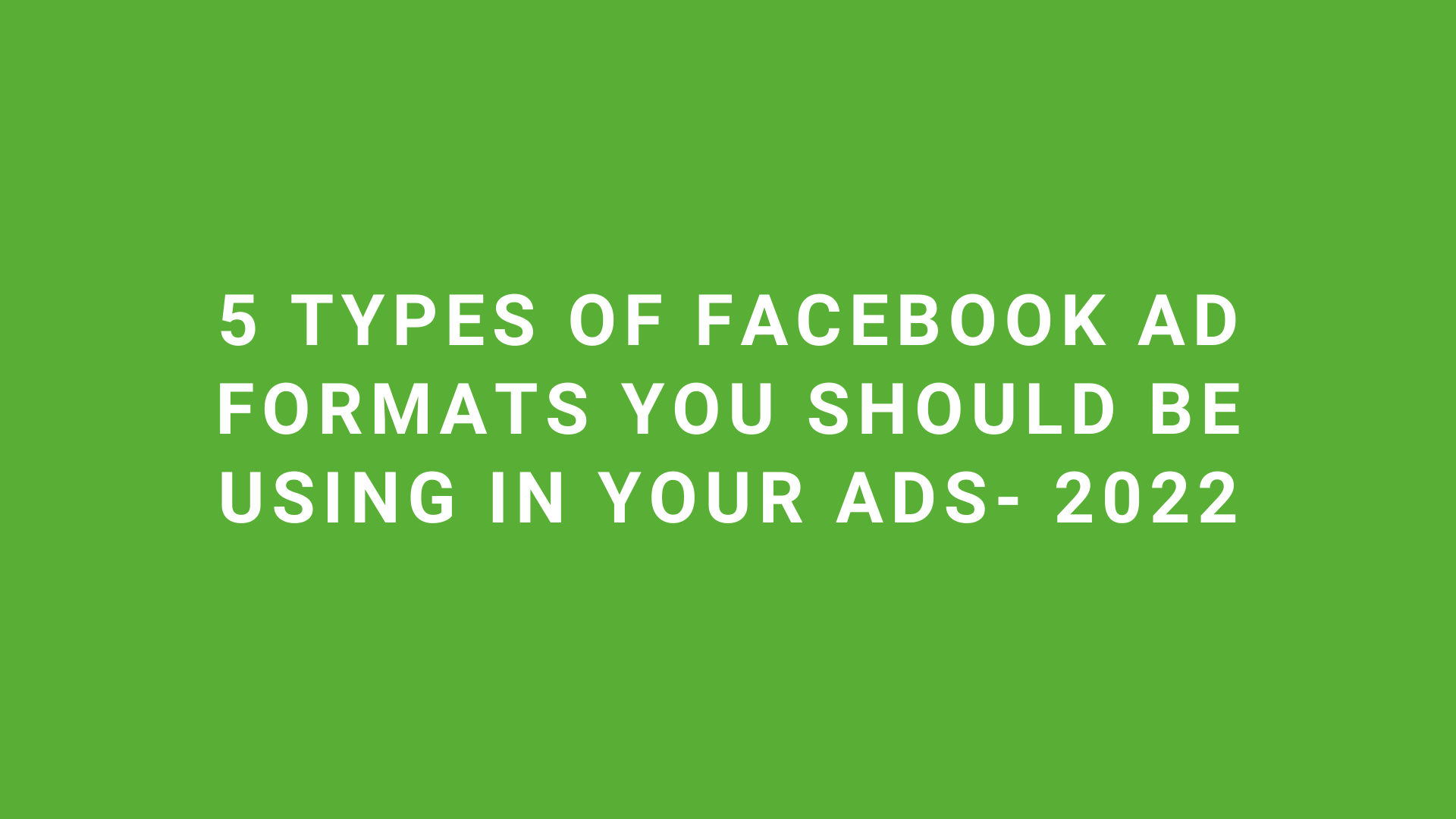You can design your ad using various formats, placements, and objectives to meet your business goals.
It is important to note that the Facebook ad formats are different from Facebook ad objectives. (To be discussed in another article)
Also, we will be covering the Facebook ad placement in a separate article.
In today’s article, we will be discussing the Facebook ad formats that you can use while achieving your business goal.
Contents
What are the different Facebook ad formats to be used while creating a Facebook ad in 2022?
The way your ad is presented creatively on Facebook is called a Facebook ad format. You can choose from various ad formats for each ad objective, and not all ad formats are available for all ad objectives.
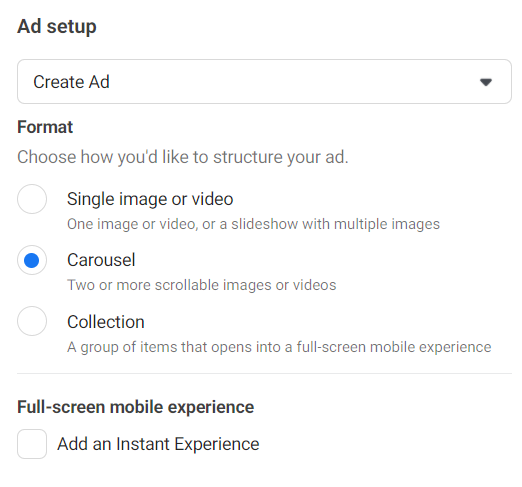
You can presently choose from the following five ad formats:
- Video ads
- Image ads
- Slideshow ads
- Carousel ads
- Collection ads
Let us discuss them one by one!
Single Image ads
Image ads are the most basic form of ad format. They consist of a single image and can be used in multiple different ad types, placements, and aspect ratios for branding purposes or conversion promotion campaigns – making them perfect for almost any stage of your funnel!
You can create Facebook image ads from Facebook’s ads manager or directly from Facebook post itself by boosting an image post.
Image ads are a great way to show off your product, but they can be limiting as you only have a single image to showcase your product or service.
The Process to create an single Image Ad:
- Select the type of ad you want to create from the Facebook ads manager. You can also choose to tick the checkbox for an Instant Experience that we will learn further. However, note that Instant Experience is only possible in mobile devices.

2. In step 2, you need to set up the details for the ad creative as shown in the image below. Later you can proceed further to allocate budget, audience & other details necessary.
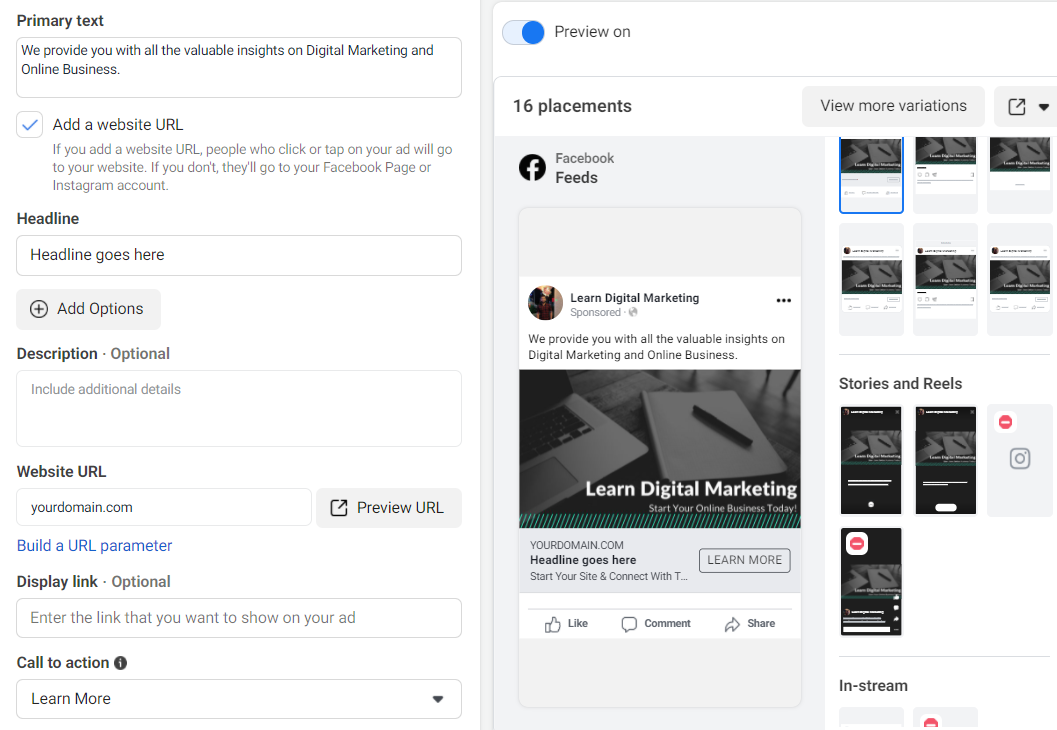
Best practices for image ads:
- Pay attention to aspect ratios.
- Use high resolution images.
- Avoid too much text on the image itself.
- Remember to preview your ads.
Ad Objectives that support Image Ads: (Based on revised Facebook ad objectives)
- Awareness
- Traffic
- App promotion
- Engagement
- Leads
- Sales
You can select from any of the above Ad objectives while creating a Facebook Image Ad.
Learn more about image ads specs.
Video Ads
The video ads are pretty self-explanatory. They’re advertisements in the video format. Video advertisements are the most valuable tools in advertising and promoting the business.
Video ads use a single video to market your product or service. They are more engaging than any other format & therefore have a high audience engagement rate.
The auto-playing feature allows you to capture user attention while scrolling through the feed quickly.
You can create the following types of video ads:
- in-stream video ads- Ads that play while people are watching video content
- Feed video ads- Share videos while people are scrolling through their feed
- Stories video ads- More popular these days is to capture people’s attention in the story format
Remember that you don’t have to film your video; instead, you can use a GIF video or an animation to deliver your message.
How can you create a Video ad?
You can create video ads from a Facebook ads manager account or directly from a FB page by selecting a video post.
The only drawback of video ads is that they are time-consuming to create. So, when you have a simple message to convey at that time, you can use a simple image or a carousel ad.
The Process to create a single Video Ad:
The process is exactly similar to the above step in the image format. The only difference is to upload a video file instead of an image one from the “change media” option as shown below.
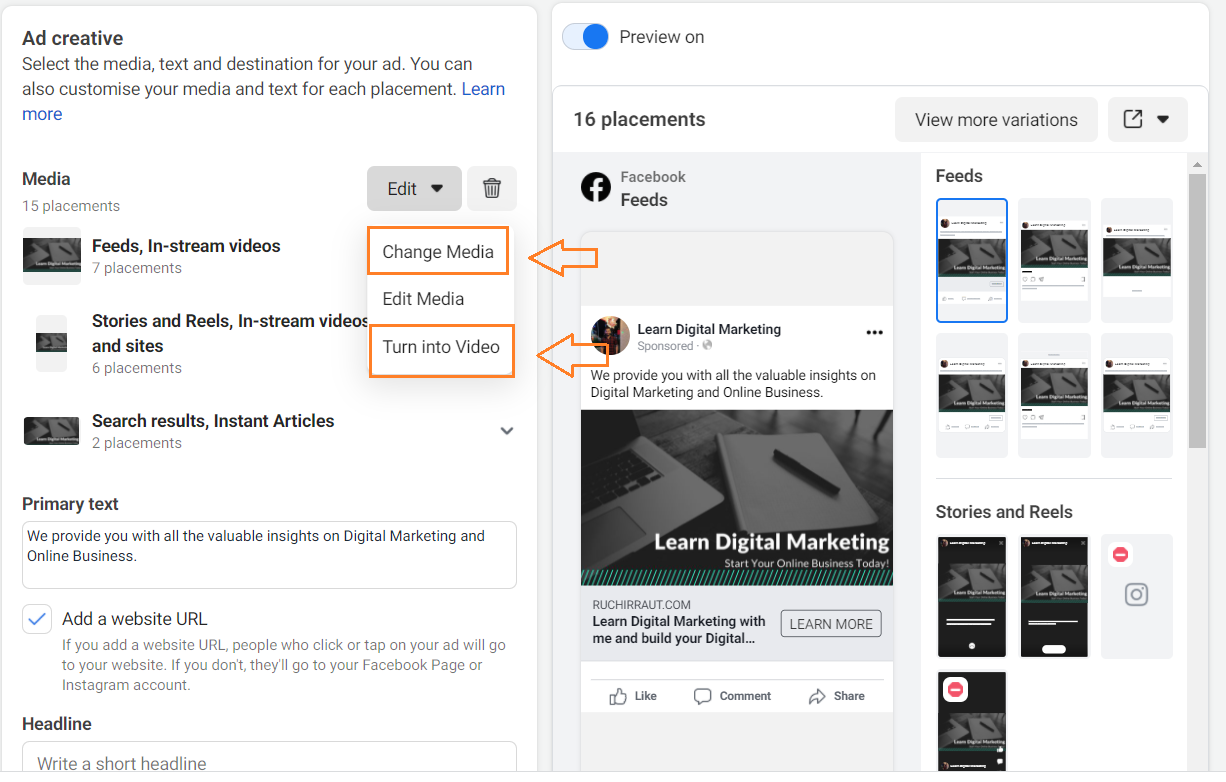
Another option that is “Turn into Video” is useful when you want to create a slideshow that we will be discussing further.
Where can you place a video ad?
Video ads can run in your news feed, stories, or other longer content like in-stream ads. However, creating a video ad requires a creative approach similar to image ads.
Best practices for image ads:
- Keep videos short- around 15 sec as people are more likely to watch until the end.
- Start your video with a catchy phrase & convey your objective immediately.
- Use vertical videos as most people tend to use their mobile phones vertically. Try to use a 4:5 aspect ratio.
- Create video ads that can be understood even without a voice, as most people view them in public places. Try to use text, caption & graphics in your video ads.
Ad Objectives that support Video Ads:
- Awareness
- Traffic
- App promotion
- Engagement
- Leads
- Sales
You can select from any of the above Ad objectives while creating a Facebook Video Ad.
Learn more about video ads specs.
Slideshow ads
Slideshow advertising offers an easy way to create short video ads from the collection of still images, existing video clips & text.
When you select slideshow ad format, you have to upload a minimum of 2 to a maximum of 15 images. Facebook will automatically turn it into a slideshow.
The Process to create a Slideshow Ad:
- You can create a slideshow ad by selecting the single image/video option as shown below.

2. Select the “Turn into video” option to turn your single image into a slideshow.

3. Next you can add up to 2-15 images to create a slideshow effect with many other options available like swipe, frame an image, etc.
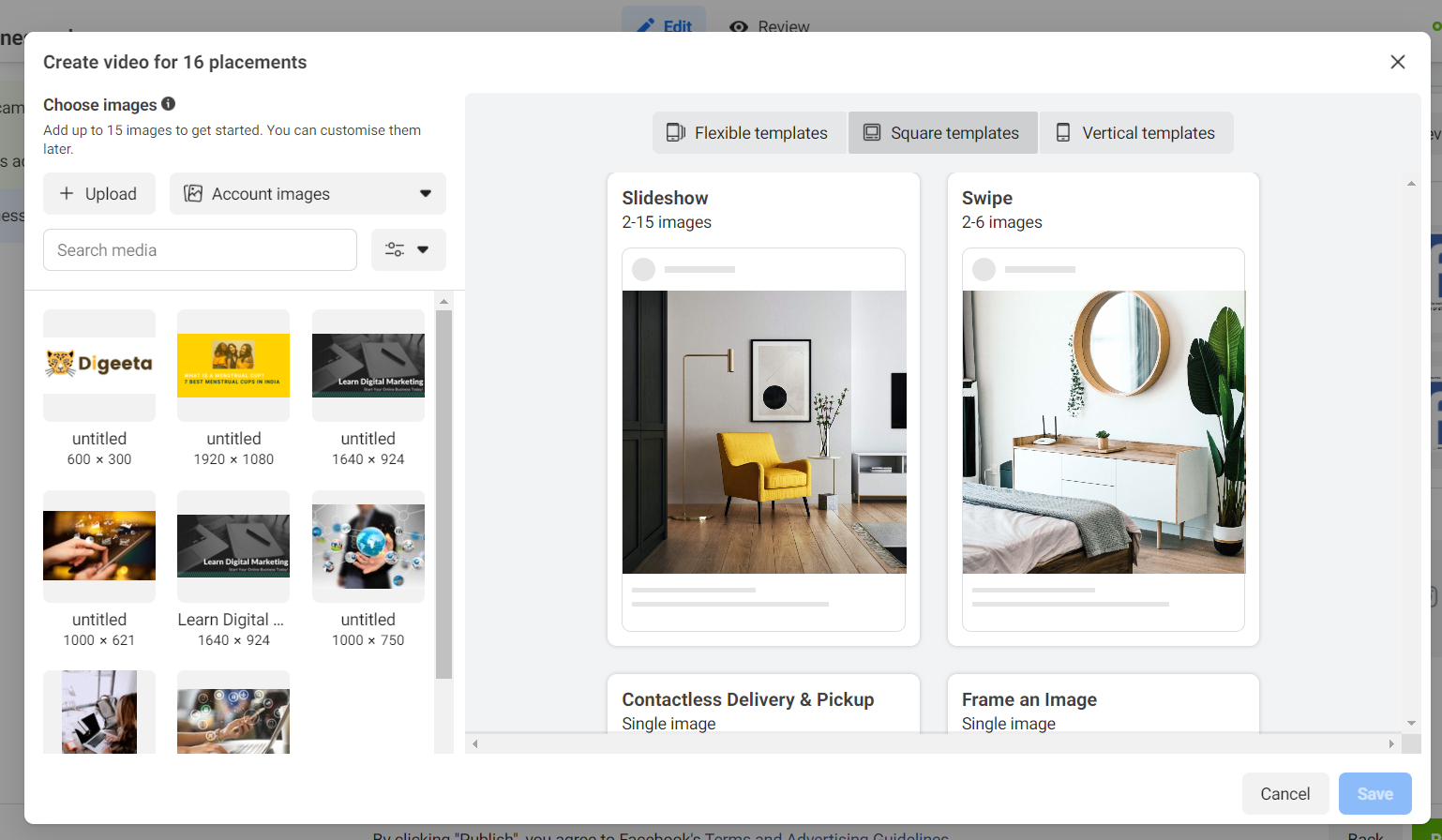
Advantages of slideshow ads:
- They are a faster & easier alternative to video ads. They are easy to create & consume up to times less data than video ads.
- People with no prior experience in video creation can go for it.
- They try to create an engaging experience for the users, just like video ads.
- They load quickly & therefore can be played on any internet connection speed.
- They help you to walk through a complicated sequence into manageable steps.
- Slideshow ads will automatically play in a loop like a video.
Best practices for image ads:
- Use high-quality images & videos.
- Use copyright-free music.
- Target slow internet connection areas.
Facebook improved the game with slide-share ads, offering a variety of new formats, including audio, video, text overlays, and other fun features.
Tip- Use an eye–catchy thumbnail to grab attention & use your most captivating images at the Slideshow’s beginning.
Ad Objectives that support Slideshow Ads:
- Awareness
- Traffic
- App promotion
- Engagement
- Leads
- Sales
Learn more about slideshow ads specs. (Same as video ads)
Carousel ads
Carousel advertising allows readers to browse several pictures or videos, each of which has a unique title, description & CTA. You can use up to 10 images or videos to showcase your product or service in the carousel.
The Process to create a carousel ad is very simple. Just select the carousel option & add multiple images (upto 10) to it.
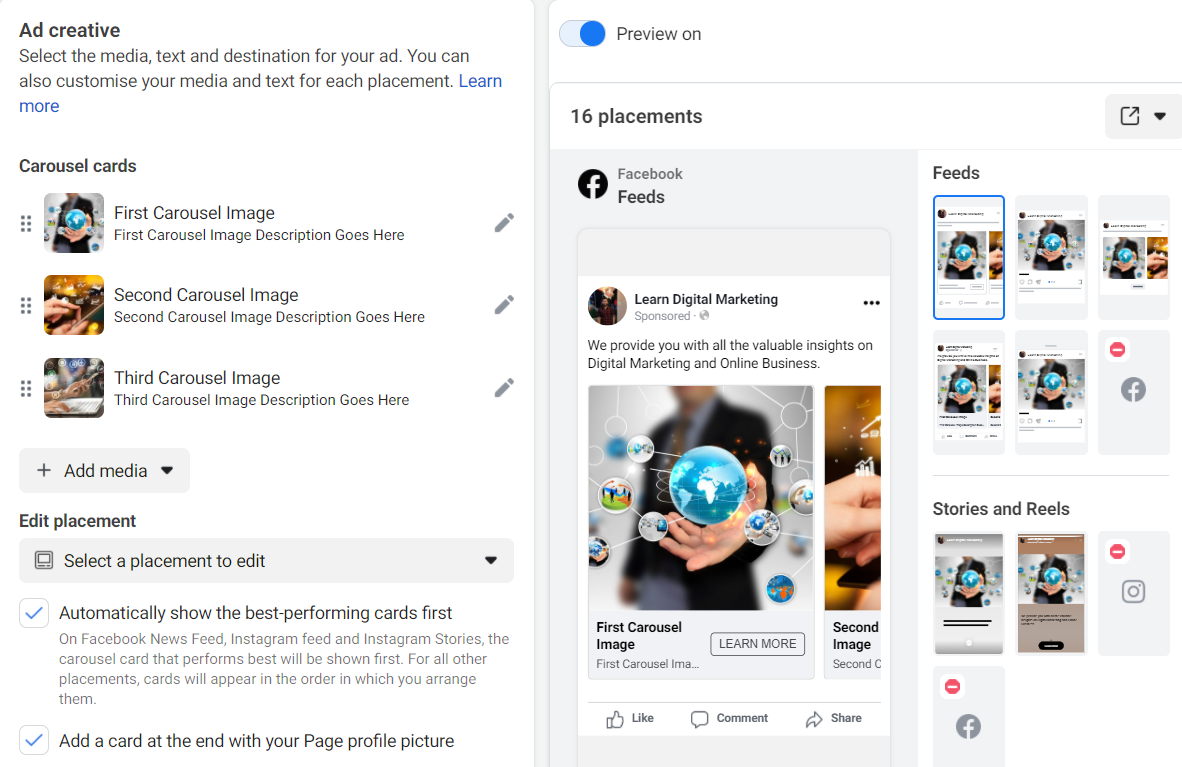
Benefits of Carousel ads:
- Carousels can be very useful when introducing a reader to a wide array of your products, as all of the images can have unique landing pages specific to that product.
- To highlight the different benefits of the product.
- Use all photos together to create one large panorama.
- The carousel format may even be effective in telling and explaining stories by dividing different carousel parts.
Difference between the Slideshow ad & the Carousel ad?
In Slideshow ads, there is only a single landing page with a single headline, description & CTA. In carousel ads, each card has a separate headline, description & CTA. Also, each card is linked to a separate landing page.
In general, carousel ads perform better since it has more information in a single ad & multiple options to choose from.
Best practices for Carousel ads:
- To have a unique headline, description & CTA for every image in the carousel.
- Link each card with a unique & matching landing page.
- Use an extensive product set (max up to 10) to represent more information & options to the user.
- Use engaging images & videos, and the one’s more attractive should be kept first.
Ad Objectives that support carousel Ads:
- Awareness
- Traffic
- App promotion
- Engagement
- Leads
- Sales
Learn more about carousel ads specs.
Collection ads:
A Collection ad is similar to a mobile window-shopping experience, where readers may scroll through your product lineup with only one tap.
Collection advertisements are similar to carousel ads in that they both display your product lineups, but Collection ads are more customizable and full-screen. They are offered only for mobile devices.
The collection format includes an Instant Experience, which allows people to discover, browse, and purchase products and services from their phones in a visual and immersive manner. Your collection ad will include a cover image or video, as well as multiple products displayed beneath it. When a user taps on the ad, a full-screen Instant Experience will appear.
The primary purpose of Collection advertisements is to make it easier for customers to find, search for, and buy products and services from their portable devices.
With Carousel ads, users can swipe through the products, tilt images in different directions, zoom in & zoom out, making it more interactive.
Collection ads are ideal for large online stores, but there are probably better options for businesses that sell a limited number of products or services.
The Process to create a Collection Ad:
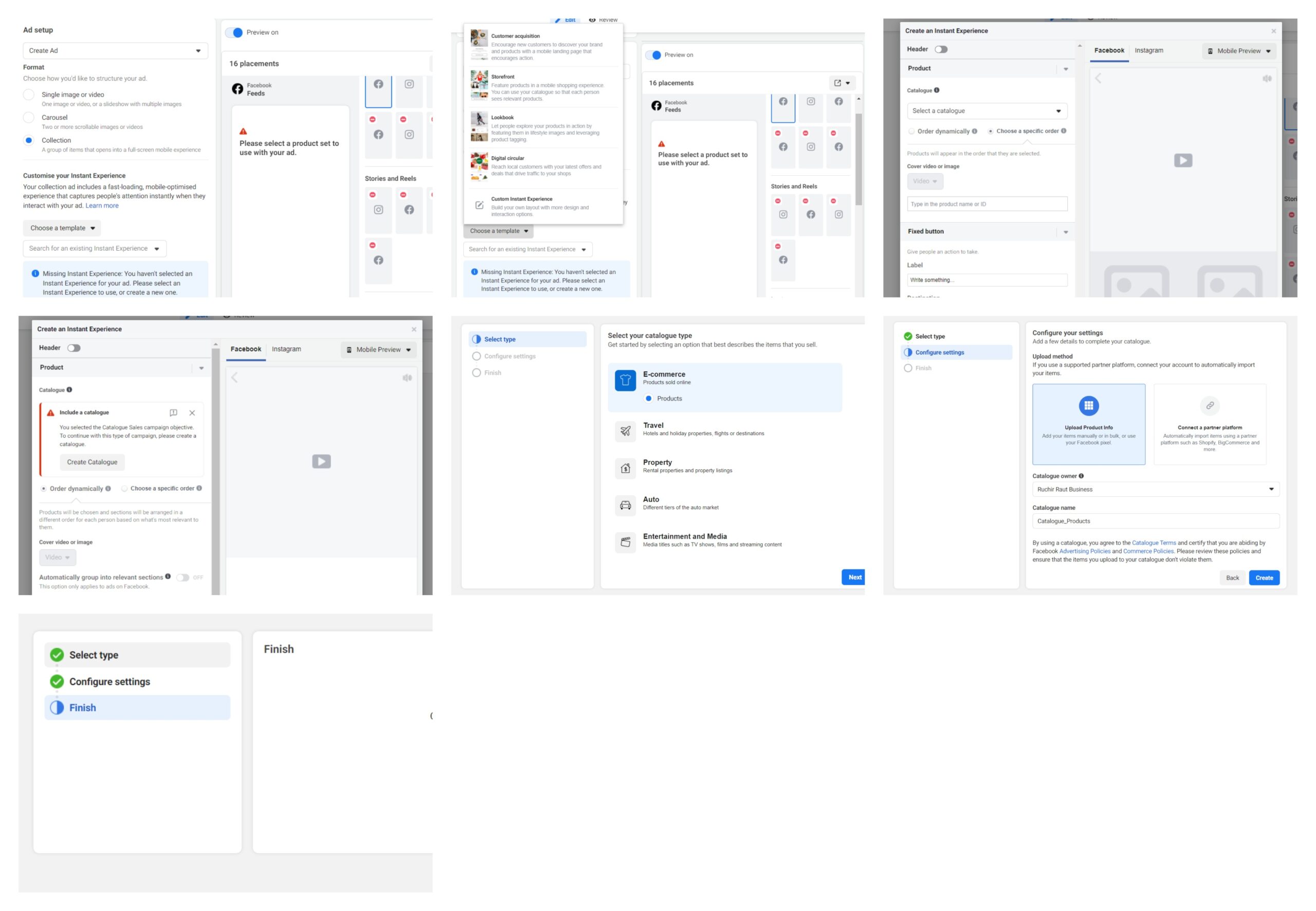
- Choose the collection ad format.
- Select the suitable template for you.
- Fill in the deails as shown in the above image & finish.
Best practices for Collection ads:
- Let Facebook’s algorithms choose products dynamically from your catalogue to display to each user.
- Fill your catalogue with a wide range of products Facebook can select.
- Select appealing product images to entice visitors to click on the ad.
- Include a cover image or video that captures attention.
- Add a URL parameter to your ad to identify where your ad traffic is coming from.
Ad Objectives for Collection Ads:
- Awareness
- Traffic
- Sales
- App promotion
Learn more about Collection ads specs.
Conclusion:
If you’re looking to grow your business, then Facebook advertising is a great place to start. You can use the various Facebook ads formats and placements options available on Facebook for different objectives that meet your company goals. Let us know what type of ad format you prefer in the comment section below!
